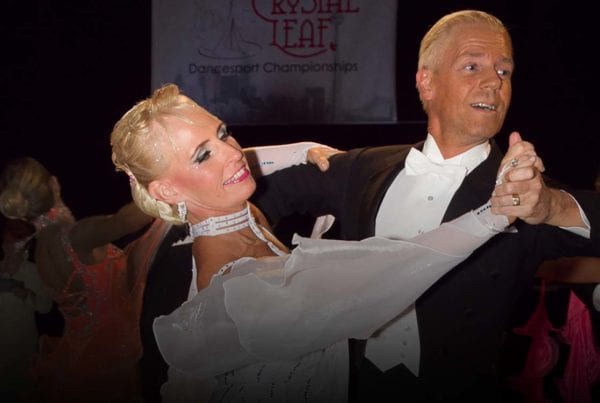Just the other day I was watching a great lecture on Floorcraft by Fabio Selmi from The Camp in 2013. It’s a lot of fun to watch because his demo couple, none other than professional world champions Mirko Gozzoli and Edita Daniute, repeatedly frustrate him by not doing what he wants to illustrate, leading to some hilarious moments. One of the most dynamic couples in the world, Mirko and Edita are so amazing to watch that even Fabio gets lost in it at one point and loses track of his presentation.
Mirko and Edita represent the best the WDSF has to offer and they are beautiful dancers, a real thrill to watch. The other world champions, the WDC’s top professional couple, Arunas Bizokas and Katusha Demidova, are also a thrill to watch, the essence of perfect technique. I believe both couples are beautifully artistic and creative. Yet there is a very clear difference in the style of these two couples. The term generally used to describe Mirko and Edita’s style is that their dancing is “dynamic.” Their shapes are big and dramatic. I’ve heard numerous WDSF coaches say that if you aren’t “dynamic” enough in your dancing you don’t stand a chance in competition. I find that kind of thinking interesting because Arunas and Katusha are world champions yet they are not nearly as “dynamic” as Mirko and Edita. There is much more to quality dancing than big shapes.
So what does it mean to be dynamic?
As a rule, the term dynamic refers to having large volume and presence on the floor. A dynamic couple has the ability to draw the eye to themselves through the larger top line and shaping they do throughout their performance. In practice, it’s the ability to create greater shapes through your dancing while keeping all the elements of your body completely balanced on top of each other (even as they move) and effortlessly connected to your partner. It provides more freedom of movement, more power and much more volume. But with great freedom comes great responsibility.
There is much more to quality dancing than big shapes.
Unfortunately, this trend towards being dynamic has led to extremes that are seriously unattractive and ultimately damaging to ballroom dancing’s standards of quality. Just because the world champions can do something and make it work doesn’t mean everyone else, including syllabus-level dancers, should be trying to do the same thing. For one thing, those without enough experience or knowledge simply can’t understand all the elements of creating big shapes while still being balanced themselves. And they certainly can’t understand how their shapes affect their partners or the connection between the couple.
Mirko and Edita are world champions. They generate dynamic shapes through a rich understanding of the physics of movement, rotational forces, use of energy and timing. I’ve had lessons with Mirko and with Arunas. Both are gifted, highly experienced professional dancers. Both understand far more than I ever will about the physical realities of movement. I’ll never forget a lesson with Arunas on Viennese Waltz where he calmly described rotational energy in mathematical terms, including an instant calculation, done in his head, of the foot pounds of torque created by our partnership during the Fleckerl. The professional world champions, at their exceptional skill level, can create huge and beautiful shapes because of this incredible knowledge and countless hours of teaching and practice.
Mirko and Edita like to create considerably greater shapes than Arunas and Katusha because this works for them. That doesn’t mean we should all be trying the same thing. Even Mirko and Edita are skirting the edge of acceptable movement and there are times when their shapes go across the line where beautiful ends and ugly begins. Done poorly, efforts by lesser dancers to copy them lead to all kinds of distortions that are uncomfortable to watch. We see shaping done at the wrong time. Shaping from the wrong part of the body. Ridiculous back bends by the lady with no awareness of how it affects the partner. Men who extend back even more than the lady during some movements, and so on.
In one seminar I attended, instruction was given that when transitioning from Promenade Position to Closed Position the man and lady should actually have their hips directly beside each other for a moment. The argument was that this accommodates more dynamic freedom for the lady as compared to having her thigh be slightly behind the man’s. This is wrong. There is no movement in any Ballroom dance where the couple should be directly side-by-side. Not even for a transitional moment. There are other ways to achieve the intended goal than to distort the joined shape in such a way.
With great freedom comes great responsibility.
While dancing should be dynamic, we need to be aware of the limits, and we need to manage these aspects of Ballroom (and Latin) dancing the same way we manage skill levels. Most coaches are very much aware of allowable step patterns in syllabus and explain these things to their students. They know the limits and make sure their students stay within them. They ask their students to master one skill level before they move onto another because without those foundations they will never really progress. Why not take the same approach when teaching shaping or other so-called “dynamic” qualities?
How do we respond as a dance community?
Putting this dangerous trend back into the Pandora’s Box from which it came can only happen when coaches and judges work together to help maintain the standards of quality that are essential.
Ballet hasn’t gone to crazy extremes because the professional community understands and respects the heritage and foundation of that dance. Ballroom dancing needs to respect the same historical progression. Evolution of partner dancing should be done in an organized way that maintains the standards of beauty. As we teach more dynamic dancing, we need to allow lower-level and less experienced dancers to go slowly, with minimal shaping so that they can grasp the basics of moving from foot to foot, using the correct parts of their feet, knowing when and how to create power, and how forces like body flight, sway, or centrifugal and centripetal force affects the partnership.
With this in mind, I was pleased to see the recent “state of the dance world” report from a group of professionals known as BASE. BASE stands for Body for Artistic Standards of Excellence. This commission was formed in Britain to help maintain and further the highest standards of Ballroom and Latin dancing. Founding members included Loraine Barry, Carmen, Hazel Fletcher, Denise Weavers and Kenny Welsh. Also involved are Caterina Arzenton, Michael Barr, Alison Fulham, Hans Galke, Richard and Janet Gleave, Jukka Haapalainen, Lynn Harman, Colin James, Nicola Nordin, Peter Eggleton, Evelyn Hoemann, Espen Salberg and Anthony Hurley.
With so many of the greatest names in the ballroom dance world involved, I was looking forward to their initial report and was pleased to see action in exactly the areas that concern so many teachers.
Key issues in today’s dancing
Among the key issues that were raised in the first BASE meeting were such things as excessive head rolls and lady’s “ironing board” actions where ladies in the Standard dances try to show how they can do a vertical split.
In the very seminar mentioned above, Fabio Selmi even calls out Edita herself on her now-famous head rolls, where she brings her head in towards the man and then out again. He points out that he’s not a fan of this kind of thing and he definitely doesn’t like to see too much of it, even though he acknowledges that she makes it look nice. Edita started this about three or four years back as something she did once or twice in the Tango. It was nice and I don’t have a problem with it in that dance. I actually think it works well in Tango, seemingly borrowed from Argentine Tango. But today we see every lady doing those head rolls. And not only in every dance, but many times in every dance! We’re seeing ladies doing this who have no understanding of why they are doing it or how to do it well. They just think they have to do lots of head rolls or they aren’t “dynamic” enough.
The kind of gentle admonition we see from Fabio (you can see it around 16:30 in the video above) is exactly the kind of thing that more coaches need to do.
The committee discussed the loss of musicality in dancing. In an effort to be “dynamic” there is now so much use of syncopated steps that some dances look like couples are basically just running around the room, with none of the beautiful contrast between slows and quicks.
They noted that Samba is also losing its character due to the emphasis on athleticism which puts the focus purely on speed and movement, leaving the rhythm and Samba bounce out of the equation.
Let’s be clear that this is not an argument against dynamic dancing. It’s a warning that we need to know where the limits are. Dancing should be dynamic and can be more dynamic than it is today. We can learn from great dancers who, like Mirko and Edita, set new directions we can move towards. But we must be careful to maintain quality in our dancing, not allowing things like the blind chasing of “dynamic” styling or athleticism to become more important than what these wonderful, timeless dances are supposed to be about: a beautiful expression of storytelling through two bodies moving together in harmony with music.













Mr. Pytlik,
Thanks for the great article that I appreciate very much like your many great articles!
God bless you!